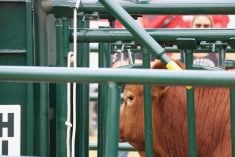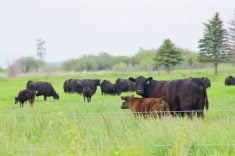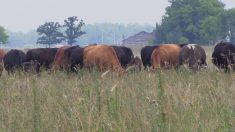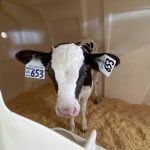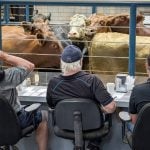Manitoba Agriculture Minister Derek Johnson hasn’t abandoned the idea of getting Manitoba’s cattle herd back to its pre-BSE size.
“Of course it’s still on the table,” he said, as he sat outside a veterinary clinic in Ste. Rose du Lac, the heart of the province’s cattle country. “It’s a very vibrant industry here in Manitoba. I grew up on a beef farm, personally, in the Interlake.”
Why it matters: Cattle numbers have been moving the wrong way if Manitoba wants to restore the size of its beef herd, but the challenges of the last few years have been the straw that broke the camel’s back for some producers.
Read Also
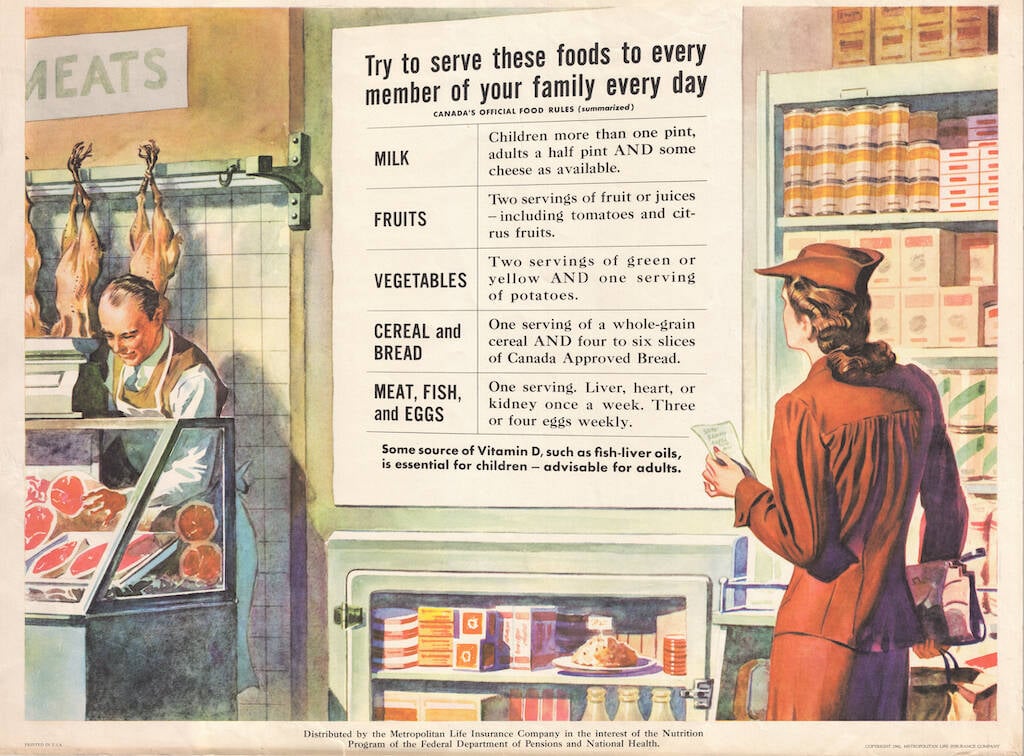
Canada’s ‘Harvest for Victory’ in the Second World War
Propaganda posters celebrating farming show the legacy of Canadian agriculture during the Second World War.
Johnson was in northwestern Manitoba to give more information about a recent promise to increase veterinary student spaces. It was one of a string of recent announcements pertaining to the cattle sector, including three years of Crown land rent reduction and a renewed public survey on agricultural Crown lands.
“Our focus is on sustainable protein and growing that industry, including the beef sector, and we’ve had a lot of announcements that we’ve done here recently that will help with that,” said Johnson, adding that details are also pending on the inclusion of Crown lands in the Sustainable Agricultural Partnership, the successor to the Canadian Agricultural Partnership.
To hear the beef sector tell it, all that help – and more – is needed.
The goal of regaining pre-BSE cattle numbers was first voiced in early 2017 by then-agriculture minister Ralph Eichler.
[RELATED] Editor’s Take: Time to get serious about rebuilding cattle sector
At the time, producers were not far removed from the cattle price peaks of 2015. Any water concerns had largely been about too much moisture, not too little. Crop reports from summer 2016 indicated good pasture conditions and ample dugout levels. Forage was also readily available.
But Mother Nature was about to place a major hurdle in front of the province’s new livestock target.
By mid-summer 2017, dry conditions were obvious. That season would ultimately begin a five-year dry spell that spanned two crisis years, widespread feed shortages and skyrocketing feed prices. It would cause the province to dissect forage insurance programs and, when circumstances came to a head with the 2021 drought, spark a $155-million AgriRecovery aid package from the federal and provincial governments.
The pendulum then swung back with a vengeance. Spring storms in 2022 ravaged the calving season for some of the province’s largest cow-calf producers. Industry in the Interlake reported average calf losses up to three or four times the average.
By January 2022, Manitoba’s cattle herd had slipped below one million head (980,000), according to Statistics Canada, compared to 1.02 million in 2017. In the cow-calf sector, a 10 per cent herd reduction was apparent, due largely to a sudden exodus of producers in the wake of last year.
Earlier this month, Ashern Auction Mart manager Kirk Kiesman told the Co-operator that he was seeing continued liquidation sales, and bred sales for the fall had been quickly filling up. Those reports echoed anecdotes from the Manitoba Beef Producers.
Getting back on track
For Tyler Fulton, president of the Manitoba Beef Producers, the way back is about setting a foundation for success.
Producers have to be able to make a profit, he says, so the systems underpinning the sector must be aimed at that outcome.
Business risk management has been a longtime sticking point for MBP and its national counterpart, the Canadian Cattle Association. The beef sector has argued that programs such as AgriStability are ill-suited for livestock production, with its considerably slimmer margins compared to annual crops.
Fulton has pushed the need to “level the playing field” when it comes to business risk management. Crops have a much more robust insurance suite, he says. The programs that do exist, such as livestock price insurance, don’t split the cost of premiums between government and producers, as crop insurance does.
Johnson said he has tasked the Manitoba Beef Producers “with coming up with some good options that we could consider as government.
“We’re definitely in those talks to move forward down that path,” he said. “We don’t have a silver bullet yet, but we’re definitely looking at options that we can implement. Of course, it takes a little bit of time.”
Forage insurance through the Manitoba Agricultural Services Corporation got an upgrade following feed shortfalls in 2019. A review of the program led to several promises for improvement, including a mechanism to smooth production history in the case of a crisis year, a more generous transportation and disaster hay benefit and production indexes based on satellite data. The first of those changes came into play in 2021.
Last year marked the first time since at least 2009 that the percentage of insured forage acres in the province topped 30 per cent, a statistic that industry linked to the changes and anticipated drought challenges.
Johnson also acknowledged the issue with profit margins, which he estimates around 4.6 per cent. A grain farm, in comparison, might have a 25 per cent margin.
“It leaves a lot less room for error before we have an issue like last year when we brought out the AgriRecovery,” he said.
Manitoba was the only province to include a herd rebuilding aspect in its AgriRecovery program, he further noted, though uptake of that program remains unclear.
Low margins are partially due to how the cattle business works, the ag minister added.
“The issue is everybody sends (the animal) to auction,” he said. “After it’s there, it’s very rare that anybody passes on an auction price because you’re in a different environment and you have the disease risk of bringing them back to the farm. Where somebody can sign a contract on a grain farm and they have more certainty of what their fall revenue is going to be.”
Johnson said he has asked the beef producers for feedback on that issue as well.
Fulton points to the opportunity cost of running cattle, given the elevated price of grain. Producers with any flexibility in their land use might find livestock a hard sell.
Crown land
Crown land leases have also loomed large in the cattle sector.
Leaseholders in the Parkland and Interlake are critical of the province’s 2019 regulatory changes to the system, which they say compounded their financial hit as those leased parcels dried up.
In particular, the new formula caused drastic rental fee increases within a span of two years.
Dale Myhre, a rancher near Crane River, said ranchers are leaving the business.
“We predicted that this was going to happen,” he said. “There was no way around it. It was obvious what was coming… We can’t afford to pay the rent, and at the same time there’s no future because we’ve lost the value of our ranches due to the changes in unit transfers.”
The former unit transfer mechanism allowed a producer to tie rights for a leased parcel in with private land when they sold the ranch. The province has argued that it artificially inflated the value of those ranches while producers (particularly those who owe the majority of their land base to leases) argued their farms are unsellable without the provision.
Likewise, those farmers argue, sudden loss of the mechanism has sent retirement plans into a tailspin.
The province recently promised to reduce rent for forage leases for the next three years. Rents will be halved next year, followed by a 33 per cent and then a 15 per cent reduction from current levels.
It has also reopened the conversation on the Crown lands system in general. A public survey is available on EngageMB and will be open until Oct. 28.
“If you look over the past decades, even with the AgriInsurance, it’s changed. It’s malleable. And our ag Crown land program that we have out there is malleable as well,” Johnson said.
“We’re a listening government and, if people fill out the survey on EngageMB, we are definitely listening.”
Unit transfers feature in the survey questions, Johnson confirmed.
However, Myhre says the promised three years of rent relief will not fix the issue. He says the issues of viability will still be there at the end of the grace period unless rents are permanently reduced and unit transfers are restored.
“One way, there’s a future and the other way it’s better for everybody to walk away,” he said.






